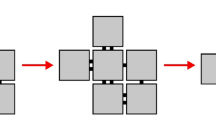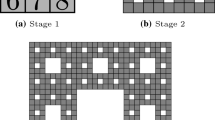Abstract
Discrete self-similar fractals have been used as test cases for self-assembly, both in the laboratory and in mathematical models, ever since Winfree exhibited a tile assembly system in which the Sierpinski triangle self-assembles. For strict self-assembly, where tiles are not allowed to be placed outside the target structure, it is an open question whether any self-similar fractal can self-assemble. This has motivated the development of techniques to approximate fractals with strict self-assembly. Ideally, such an approximation would produce a structure with the same fractal dimension as the intended fractal, but with specially labeled tiles at positions corresponding to points in the fractal. We show that the Sierpinski carpet, along with an infinite class of related fractals, can approximately self-assemble in this manner. Our construction takes a set of parameters specifying a target fractal and creates a tile assembly system in which the fractal approximately self-assembles. This construction introduces rulers and readers to control the self-assembly of a fractal structure without distorting it. To verify the fractal dimension of the resulting assemblies, we prove a result on the dimension of sets embedded into discrete fractals. We also give a conjecture on the limitations of approximating self-similar fractals.












Similar content being viewed by others
Notes
Carbone and Seeman proposed an approach to the self-assembly of the Sierpinski carpet using specially designed molecules and a process requiring physical intervention at each successive stage of the fractal [2]. However, there is no direct translation of their approach into a model of self-assembly such as the aTAM.
References
Adleman, L., Cheng, Q., Goel, A., Huang, M.D.: Running time and program size for self-assembled squares. In: Proceedings of the 33rd Annual ACM Symposium on Theory of Computing (STOC 2001), pp. 740–748. ACM, New York (2001)
Carbone, A., Seeman, N.C.: A route to fractal DNA-assembly. Nat. Comput. 1, 469–480 (2002)
Carbone, A., Seeman, N.C.: Coding and geometrical shapes in nanostructures: a fractal DNA-assembly. Nat. Comput. 2, 133–151 (2003)
Cheng, Q., Goel, A., Moisset, P.: Optimal self-assembly of counters at temperature two. In: Proceedings of the 1st Foundations of Nanoscience: Self-Assembled Architectures and Devices (FNANO 2004), Snowbird, UT (2004)
Doty, D., Gu, X., Lutz, J.H., Mayordomo, E., Moser, P.: Zeta-dimension. In: Jedrzejowicz, J., Szepietowski, A. (eds.) Mathematical Foundations of Computer Science 2005: 30th International Symposium (MFCS 2005), Gdansk, Poland, August 29–September 2, 2005. LNCS, vol. 3618, pp. 283–294. Springer, Berlin (2005)
Graham, R.L., Knuth, D.E., Patashnik, O.: Concrete Mathematics. Addison-Wesley, Reading (1994)
Kautz, S.M., Lathrop, J.I.: Self-assembly of the Sierpinski carpet and related fractals. In: Deaton, R., Suyama, A. (eds.) DNA Computing and Molecular Programming: 15th International Conference (DNA 15), Fayetteville, AR, USA, June 8–11, 2009. LNCS, vol. 5877, pp. 78–87. Springer, Berlin (2009)
Kautz, S.M., Shutters, B.: Supplementary materials (2012). www.cs.iastate.edu/~shutters/saragsc
Lathrop, J.I., Lutz, J.H., Summers, S.M.: Strict self-assembly of discrete Sierpinski triangles. Theor. Comput. Sci. 410, 384–405 (2009)
Lutz, J.H., Shutters, B.: Approximate self-assembly of the Sierpinski triangle. Theory Comput. Syst. 51(3), 372–400 (2012)
Patitz, M.J.: Simulation of self-assembly in the abstract tile assembly model with ISU TAS. CoRR arXiv:1101.5151 (2011)
Patitz, M.J., Summers, S.M.: Self-assembly of discrete self-similar fractals. Nat. Comput. 9, 135–172 (2010)
Razpet, M.: The Lucas property of a number array. Discrete Math. 248, 157–168 (2002)
Rothemund, P.W.K.: Theory and experiments in algorithmic self-assembly. PhD thesis, University of Southern California, Los Angeles, CA (2001)
Rothemund, P.W.K., Winfree, E.: The program-size complexity of self-assembled squares. In: Proceedings of the 32nd Annual ACM Symposium on Theory of Computing, pp. 459–468. ACM, New York (2000)
Soloveichik, D., Winfree, E.: Complexity of self-assembled shapes. SIAM J. Comput. 36, 1544–1569 (2007)
Wang, H.: Proving theorems by pattern recognition, II. Bell Syst. Tech. J. XL(1), 1–41 (1961)
Winfree, E.: Algorithmic self-assembly of DNA. PhD thesis, California Institute of Technology, Pasadena, CA (1998)
Acknowledgements
We thank Jack Lutz and Jim Lathrop for useful discussions, Matt Patitz for the ISU TAS software, and an anonymous referee for several valuable comments.
Author information
Authors and Affiliations
Corresponding authors
Rights and permissions
About this article
Cite this article
Kautz, S.M., Shutters, B. Self-Assembling Rulers for Approximating Generalized Sierpinski Carpets. Algorithmica 67, 207–233 (2013). https://doi.org/10.1007/s00453-012-9691-x
Received:
Accepted:
Published:
Issue Date:
DOI: https://doi.org/10.1007/s00453-012-9691-x




